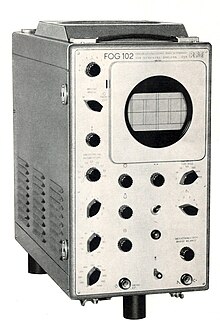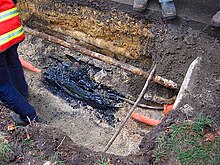User:MBehringer/sandbox
Cable fault location is the process of locating periodic faults, such as insulation faults in underground cables, and is an application of electrical measurement systems. In this process, mobile shock discharge generators are among the devices used.

History of cable fault location in the former German Democratic Republic[edit]
Cable fault location had its beginnings in post-war Dresden, when in 1948 the radio manufacturer Radio Mende was expropriated and transformed into a Soviet-German limited company SDAG with the new name Funkwerk Dresden. Since a number of experts in the field of pulse technology were available, the decision was made to focus on cable testing equipment and implement ideas for a fault location device. Thus, in 1952 the first fault location device FOG 101 was created for overhead lines. The majority of those produced devices were delivered to the USSR as war reparations.
Because of restructurings within the GDR, Funkwerk Dresden was in 1969 initially merged with other Dresden companies into VEB, RFT Messelektronik “Otto Schoen”, which it remained until becoming integrated in 1979 in the state combine Robotron. After dissolution of the VEB Kombinat Robotron in 1990 and the opening of the markets in connection with the German reunification, the Messelektonik Dresden company had to be made competitive. The company headquarters was moved to Radeburg in Sachsen and a merger partner was found in Salzgitter Elektronik Ltd. The company that arose from the merger, Hagenuk KMT, soon ran into problems however, due to the collapsing markets in the eastern block, which led to the closure of the Kiel site and the elimination of 320 jobs. In 1995, the upper Franconian Seba Dynatronic® Mess- und Ortungstechnik Ltd. took over the financially stricken subsidiary of the Hagenuk Group. From that point onward, the absence of existential fears meant the focus could be returned to the development of new products. The SebaKMT-Group was founded in 2000, and now comprises 5 companies supplying cable testing equipment.

| Company name [1] | Date of founding/acquisition | Details of acquisition |
|---|---|---|
| Radio Mende | 1923 | |
| Funkwerk Dresden | 1948 | Expropriation by the Russian occupying forces |
| Seba Dynatronic | 1951 | Founding of Seba Dynatronic Mess- und Ortungstechnik Ltd |
| VEB RFT Meßelektronik | 1969 | Merger with VEB Vakutronic, VEB Schwindungstechnik und Akustik Dresden |
| VEB Robotron-Meßelektronik 'Otto Schoen' Dresden | 1979 | Integration in the state combine Robotron |
| Hagenuk KMT Kabelmesstechnik Ltd | 1991 | Merger of Salzgitter Elektronik Ltd with the former subdivision of Robotron-Messelektronik Dresden |
| Hagenuk KMT Kabelmesstechnik Ltd | 1995 | Acquisition by Seba Dynatronic |
| SebaKMT-Group | 2000 | Joint sales organisation of Seba Dynatronic, Hagenuk KMT, Metrotech, HDW Electronic and Vivax (acquired 2007) |
Cable faults[edit]

Cable faults are damage to cables which effect a resistance in the cable. If allowed to persist, this can lead to a voltage breakdown. There are different types of cable faults, which must first be classified before they can be located. The insulation of the cable plays a significant role in this. While paper-impregnated cables are particularly susceptible to external chemical and thermal influences, in high-voltage PE and XLPE cables the polyethylene insulation of the conductor is affected, leading to partial breakdowns and cracks that “eat away” the insulation.
Screening faults[edit]
A contact between conductor and screen generates a varying resistance.
Phase faults[edit]
The contact between multiple conductors generates a varying resistance.
Sheath faults[edit]
Sheath faults are damage of the cable sheath that allows the surroundings contact with the cable screen.
Faults due to moisture[edit]
Water penetrates into the cable sheath and contacts the conductors. Impedance changes at the fault location make measuring more difficult. The resistance usually lies in the low-ohmic range.
Disruptions[edit]
Combination of series and parallel resistances, usually in the form of a wire break. The voltage is interrupted , i.e. Ω=∞ .
Cable testing[edit]
To locate a fault in the cable, the cable must first be tested for faults. Cable testing is therefore usually performed first in cable fault location. During the cable test, flash-overs are generated at the weak points in the cable, which can then be localised.
Locating the cable fault[edit]


The measures necessary for determining fault locations can be subdivided into individual steps.
Fault classification[edit]
Insulation and resistance measurement provides information on the fault characteristics. An insulation test measures the insulation resistance between conductor and screen; from the periodic measurement of resistance you can derive the absorption properties of the insulating material.
Pre-location[edit]
Pre-location is used to determine the fault distance. There are predominantly two methods for this.
Pulse reflection method[edit]
A pulse induced at the starting end of the cable reaches the cable fault with a speed of v/2 and is there reflected back toward the starting end of the cable. The elapsed time multiplied by the diffusion speed v/2 gives the distance to the source of the fault. See also: [1].
Transient method[edit]
In the transient method, a breakdown is triggered at the cable fault. This effects a low-resistance short circuit for a few milliseconds. This in turn produces two travelling waves diffusing in opposite directions. These waves are reflected at the cable ends so that they then travel toward each other again in the direction of the cable fault. The waves are unable to pass the fault because of the arc produced by the short circuit, so they are therefore reflected back again as with the pulse reflection method, which due to the burning short circuit results in a reversal of polarity. There are various ways to decouple and analyse these transients.
Route tracing and pinpointing[edit]
Route tracing is used to determine where the faulty cable lies and pinpointing is the process of determining the exact position of the cable fault.
Cable identification[edit]
In cable identification, the faulty cables are identified from the fault-free cables at the already determined site.
Fault conversion[edit]
After the cable fault is identified and located, it is then possible to “burn it in” using burner devices, in other words to convert it from a low-resistive to a high-impedance fault.
Cable test van[edit]
The conventionally used aid in cable fault testing and location is the cable test van. The van is installed with conventional cable measuring systems for quickly reaching the location of any cable fault. In 20 years that followed, over 2000 fault location vehicles were manufactured, more than half of which were intended for the former USSR. These methods of cable fault location quickly became established in Western Europe as well.
External links[edit]
- The history of Seba Dynatronic
- Measuring methods in cable fault location
- Cable fault location in low- and medium-voltage cables
- Methods of classical high-voltage cable fault location in connection with reflection measurement and software algorithms

